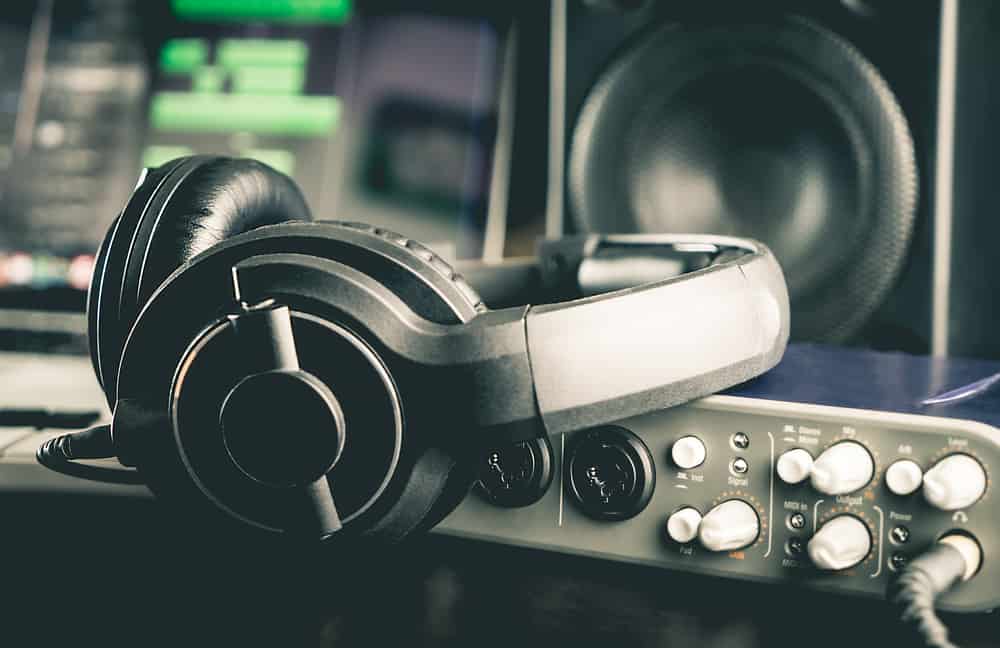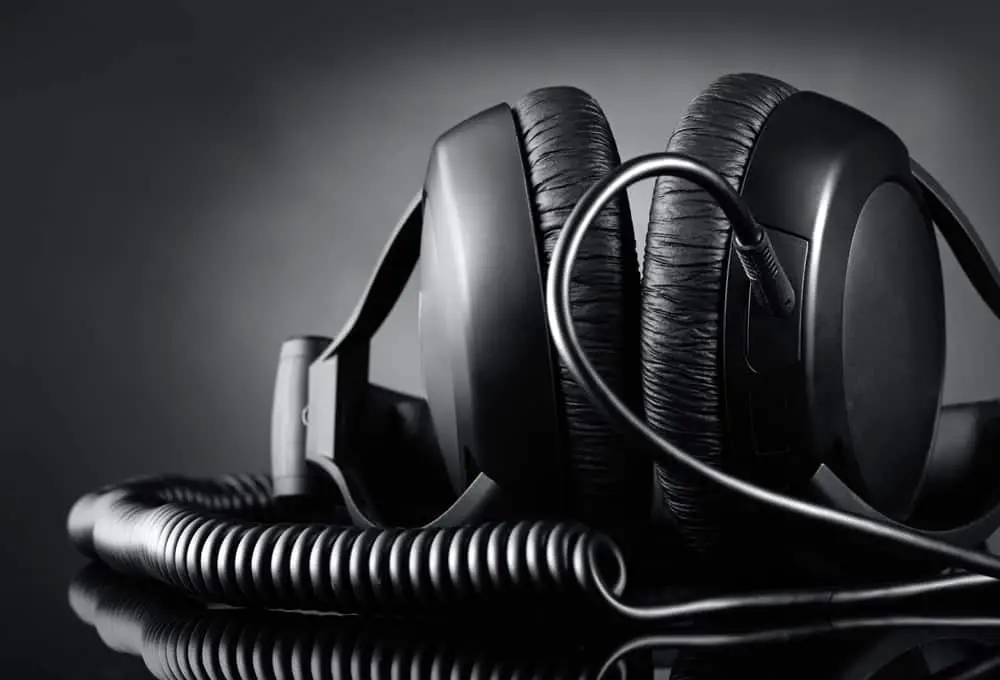
Sometimes using studio monitors for your mixing and production just won’t cut it, and you want to focus on those little details, and that’s where studio headphones come in. Besides getting various studio headphones, where would you plug them in, and do they require anything else?
Having an audio interface is not required, but in some regards, it is. There is no other way you will be able to mix and listen to music if you are in the studio without an audio interface, and with that, you will be plugging your studio headphones into it. Depending on the studio headphones and their impedance, they may also require an amplifier.
This article will briefly cover the various types of studio headphones in order to better grasp how they work. With that, we will take a look at studio headphones that have a high impedance and if they require an audio interface, and then we will look at standard studio headphones that do not have a high impendence.
Studio headphones overview
Studio headphones are a far cry away from the headphones of yesteryear, with them being made of superior materials, having better technology, some even being wireless, and now many coming in the for of varying degrees of power (ohms).
This means that for all intents and purposes, you can’t just go plugging your studio headphones in wherever you like, and depending on the make and model, your headphones may require external features like a power source.
Before we can consider if your studio headphones can be plugged into your audio interface and if they should, for that matter, let’s compare the different types of studio headphones for a little bit of a better understanding.
Studio headphones vs consumer grade headphones
You may be thinking that you plug your normal headphones in anywhere, and they sound great, so surely the same would apply to your studio headphones. Well, not really. The reason for this is because consumer headphones have their frequencies adjusted so that whatever you listened to will be “tuned” in a way. Manufacturers will amplify and cut well-known frequencies that improve the sound listening experience, and for studio purposes, this is a no-no.
Typically the bass frequencies and the higher frequencies passed 10kHz will be amplified to give the audio (music) you listen to more bass and airiness.
Studio headphones are designed to have a flat response meaning that the manufacturers do not emphasize any particular frequency. In a perfect world, the headphones, when shown on a graph of frequencies,s would be a straight line, and for the most part, manufacturers do get this almost correct.
Closed back studio headphones
As the name suggests, these headphones have a closed-back which ensures that no sound can escape. Furthermore, it isolates the listener from any outside distractions which you typically want if you are in a studio situation.
Having a solid ear cup (closed back) also helps to focus on the audio. Hence, a producer or engineer can pick up minute details that they otherwise would not have. Moreover, these types of headphones are also beneficial in the studio for recording artists and instrumentalists for the same reason.
Having these types of headphones will allow a vocalist or guitar player just to hear their guitar and anything else they would like in the headphones. This makes for great recordings.
Check out this great pair of closed back studio headphones on Amazon.
Open back headphones
As you would have guessed, these headphones are open and do not have a solid ear cup. Typically they will have some perforated rear that allows the air to flow through them. Due to these headphones having an open back, more ambient noise will be filtered through to the listener, which may be a bit distracting, but there is a benefit to these.
Due to the open back, many frequencies that are considered harsh or dry are able to escape and will not bounce back into the listener’s ears. These are great because if you are working with bass-heavy tracks, you may sometimes think that the bass is too much, but it is just the reverberations and echoes bouncing off the closed-back ear cups. Hence, you will mix the bass flatter to find out when listening to the audio on another device that the bass is too weak.
Check out this great pair of open back studio headphones on Amazon.

Concerning studio headphones with a high impedance, amps, and audio interfaces
Besides the varying types of headphones, you now get headphones that require an amplifier of sorts because they are so powerful. This can play a part in connecting them up to your audio interface because you may have an audio interface that comes specifically equipped to handle headphones with a high impedance.
Impedance is a measurement used to see how much something resists electrical current. Headphones that are built with a high impedance can result in the audio having a much better overall sound quality. We discussed the various types of studio headphones above, and this can be applied to them all.
Studio headphones with a high impedance mean that they will provide better sound quality and need an amplifier to drive them properly. If your headphones do not get enough power and they have a high impedance, the audio will more than likely be soft, poor, and in some cases, inaudible.
If your studio headphones are 50 ohms or higher, then it is best if you get an amplifier to drive them or if your audio interface has a built-in headphone amp, then you should definitely be using your headphones with it. One thing to note is that only top-tier rackmount audio interfaces will typically have a headphone amplifier.
Otherwise, what you will do is purchase an amplifier and connect this up to your audio interface. You will need to use an online headphones calculator to determine the amplifier’s power that you need.
Due to many headphones having variable impedances, getting an amplifier that is a little more powerful than what you need is optimal. Check out this video below if you are still confused.
Check out some of these great headphones amplifiers on Amazon here
What if my studio headphones don’t have a high impedance?
For the most part, you will always still want to plug your headphones into your audio interface because of the monitoring ability. Your audio interface and all audio interfaces have a monitor knob that allows for adjustment, which you can use to hear the audio with no latency. This can be really beneficial in the studio.
Besides that amazing feature which is needed in the studio all the time, there is no other place to insert your headphones other than into a DAC or amplifier and then still route it to your interface.
What about plugging my headphones into the PC or laptop?
In no studio scenario will you ever be plugging your headphones into your PC, and there are many reasons for this. Firstly this is because your DAW (digital audio workstation) will only allow for one sound device to be active at any one time. This means that even if you do plug your headphones into your PC, you will not be able to hear any audio.
Another reason is that if you do manage to select the audio device on your machine, that latency will be so bad that your mix and production will suffer to a large degree, and no matter what headphones you are using, they will not help. This is because latency has to do with signal speed and not the quality of sound. Although running any form of DAW through your standard computer audio soundcard will not result in the best quality sound.
Conclusion
You get two main types of studio headphones, namely closed and open-back headphones, with pros and cons for both. Furthermore, you can also get these headphones that will also have a higher impedance meaning their audio quality will be better; however, you will probably need a headphone amplifier if you intend them to function correctly.
If you have headphones like this, you are probably already running them through an amplifier and into your audio interface or through an audio interface with a built-in headphone amp.
Even if you don’t have studio headphones with a high impedance, you should always consider inserting and listening to your audio through your audio interface due to its headphone’s monitoring function and due to its superior audio quality, and low latency.
You can learn more about when you need an audio interface here.
Source list
The Different Types of Headphones for Music Production Explained


